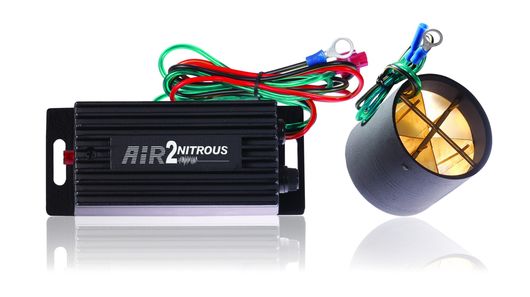Air2Nitrous device claimed to cut vehicle exhaust emissions by 90 percent
May 26, 2015

The Air2Nitrous device can be retrofitted to existing vehicles to slash emissions
Driving an electric car that gives off no emissions is one of the best ways to reduce your personal transport carbon footprint. But if an EV is out of reach, the next best thing could be a simple retrofittable, scalable device called Air2Nitrous (A2N). Its creators claim it can reduce engine emissions by 90 percent, while cutting fuel consumption by 20 percent.
The Air2Nitrous team describes its electronic emissions control system as a "first phase" device because it works before and during combustion. It cuts emissions by increasing the amount of oxygen molecules and decreasing the amount of nitrogen molecules in the combustion chamber.
As air from the atmosphere passes through the vehicle’s air filter, it then passes unobstructed through the converter ring located in the air intake duct. At this point, the reactor exposes the air to electrical discharges, separating nitrogen (N2) and oxygen (O2) from the atmospheric air and transforming it into nitrous oxide (N2O), which is an enriched fuel/air mixture.
According to the company, less nitrogen means less nitric oxide and nitrogen oxide (NOx), and a decrease by up to 90 percent a range of harmful gases, including CO2. More oxygen in the combustion chamber also results in a more complete burn of particulate matter (PM) of 2.5 micrometers or less, also known as fine particles.
Vehicle and machinery operators trying A2N out are reporting fuel savings of six to 20 percent, Air2Nitrous says. The system works with combustion engines powered with various fuels, including diesel, LPG, bunker oil, gasoline, natural gas and others.
They add it takes 30 minutes to install the A2N device, a job that can be done by any mechanic to any internal combustion engine, with the benefits of the installation being immediate. They also promise A2N does not negatively impact engine performance, which is an advantage over other emissions-reducing technologies.
The company envisages several industry applications for its solution, including long haul transportation and trucking, agriculture (tractors), mining and off-road vehicles, motorcycles, diesel trains, generators, container ships and aircraft, among others.
It is hoping to have the same impact as the catalytic converter, which was introduced in 1975 to reduce emissions and help manufacturers comply with stricter US Environmental Protection Agency regulation of exhaust pipe emissions. A2N has already passed California emissions standards on vehicles with and without catalytic converters.
The device was recently shown at the Earth Day Fair organized by the American Chamber of Commerce in Shanghai on April 22, and the event was used as the product’s official launch pad. At the moment, the company is only selling units to commercial customers, although the situation will change once it raises capital to scale up production.
A2N currently has a monthly production capacity of around 2,000 units and manufactures mainly three different size units to be sold on a wholesale basis. However, it can custom-make larger units in the megawatt ranges from 1 to 9 MW engines and even larger.
Prices range from US$1,200 to $3,500, depending on engine size, which can vary from a 100cc scooter to a Super Panamax ship.
Source: Air2Nitrous
Comments:
Seems like its a high voltage low current device arcing possibly ionizing the air prior to the combustion process this could be aiding the combustion process. It is widely recognized that lightning does energize things in many ways (that are still subject to exciting research) and that has been ongoing since time immemorial. It is healthy to be cautious in appraising new innovations. Only if you have personal experience with the device can you be in a position to dismiss it out of hand.
I installed a HHO generator four years ago on my Rover 2000 tc. Cuts emissions 98%, Increases horsepower, Increases mpg. What more can you want?